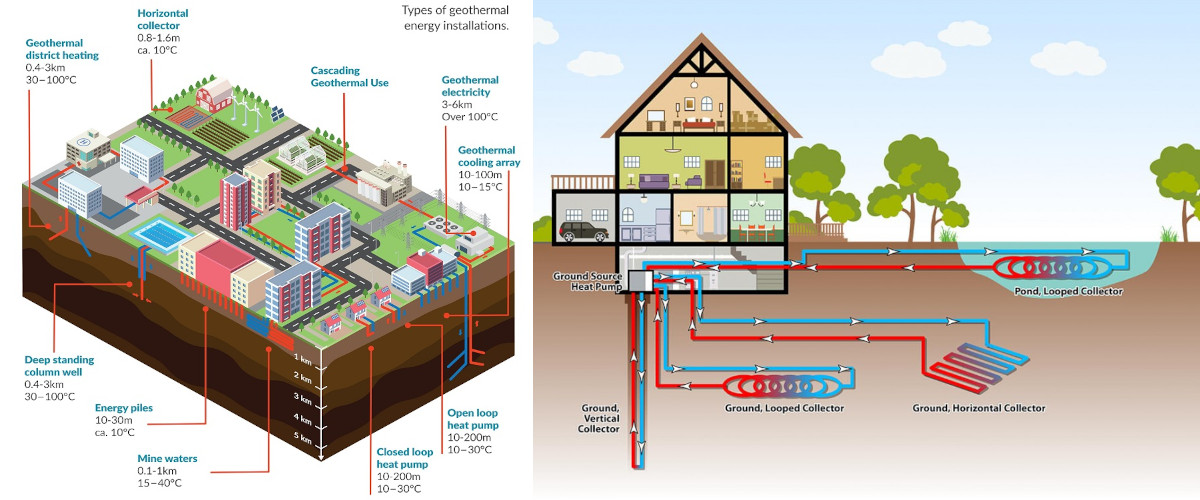Special Issue - Promoting geothermal energy applications in Europe’s existing buildings
Newsletter
Bionote
Zhengxuan Liu is a MSCA Research Fellow and Course Lecturer at Delft University of Technology, the Netherlands. He completed a joint PhD at Hunan University, China, and University of Lyon-ENTPE, France, and was Assistant Dean at Hunan University's Institute for Sustainable Urbanization & Construction Innovation. He has published over 80 research outputs, including 45+ SCI journal papers (32 as first or corresponding author), a book, 7 invited book chapters, and 35 patents. He has led 4 research projects as Principal Investigator and collaborated on 5 others. He is Associate Editor for Humanities & Social Sciences Communications and the Journal of Housing and the Built Environment.
Fan Mo is a postdoctoral researcher at the University of Cambridge, UK and the University of Nottingham, UK, as well as a guest lecturer at the Royal Institute of Technology in Sweden and Tongji University. Fan Mo is Vice Chair of the MCAA China Chapter. Previously, he served as the Deputy Minister of the Academic Department of the Oxford Chinese Students & Scholars Association
Integrating shallow geothermal energy into Europe’s existing buildings offers a sustainable solution for heating and cooling, significantly contributing to environmental sustainability and carbon neutrality. This article explores the financial, technical, and regulatory barriers to adopting geothermal technology and highlights innovative solutions to overcome these challenges in Europe’s housing sector.
Geothermal energy, as one of the most recommended renewable energy technologies, has been widely explored for building heating/cooling and carbonneutrality transitions (European Union, 2020). It offers a consistent and sustainable solution for heating and cooling buildings, distinct from intermittent renewable sources like solar and wind energy. Geothermal energy is not only available round the clock but can also be harnessed anywhere with adequate subsurface conditions, making it a versatile solution for the EU’s diverse climatic regions. Geothermal energy for heating and cooling is categorized by the depth of the heat source:
• Shallow Geothermal Heat Pumps (SGHPs): These systems operate at depths less than 5400 meters. They are simple, costeffective, and among the most efficient energy solutions in the EU (European Commission, 2021). They use the ground's stable temperature for heating in winter and cooling in summer.
• Medium-Deep Geothermal Systems: Functioning at depths between 400 and 5000 meters, these systems are suitable for district heating and cooling. They provide substantial energy for larger buildings or groups of buildings.

Integrating geothermal energy into existing buildings can significantly contribute to the EU's carbon-neutrality targets. Large-scale application is essential for reducing CO2 emissions across Europe (Ramos-Escudero et al., 2021). The latest European Geothermal Market Report (EGMR) 2022 shows a decade of growth for geothermal utilization (EGEC, 2023). However, practical applications face small-scale and low utilization rates, especially for existing buildings.
Barriers to geothermal energy adoption
Financial barriers
1. High Upfront Costs: Installation costs, driven by expenses for drilling and setting up the underground loop system, are significant. Installing a ground source heat pump system can range from €8,500 to €20,000 (Settle Down Support, NA), while conventional gas boiler systems cost €1,000 to €3,000.
2. Economic Viability of Retrofits: Older buildings often require extensive modifications to accommodate geothermal systems, increasing overall project costs. Furthermore, the complexity involved in integrating geothermal systems into existing infrastructure can escalate the cost and technical challenges, thereby reducing the feasibility of adopting geothermal energy in existing buildings.
Technical barriers
1. Installation Complexity: Installation is technically complex and requires significant expertise and resources. This complexity is heightened in urban areas and older buildings with limited space.
2. Integration with Existing Systems: Many buildings have outdated heating systems not readily compatible with modern geothermal technologies, requiring substantial modifications and upgrades.
Regulatory barriers
1. Complex Processes for obtaining permissions: Installation involves drilling, posing risks to underground infrastructure. Obtaining permits requires navigating complex local, regional, and national regulations.
2. Inconsistent Policy Support: Policy support varies across EU member states, creating an uneven playing field and hindering investments.
Social barriers
1. Lack of Public Awareness and Engagement: Many homeowners and building managers are unfamiliar with geothermal technology and its benefits, leading to hesitation and resistance.
2. Cultural and Behavioral Resistance: People are accustomed to traditional heating systems and may be reluctant to switch to new technologies.

Future solutions, directions, and recommendations
Financial solutions and incentives
1. Subsidies and Grants: Financial support in the form of subsidies and grants from governments can lower the initial investment for geothermal systems.
2. Innovative Financing Models: Models like Energy Performance Contracting (EPC) and Property Assessed Clean Energy (PACE) financing can promote adoption by reducing upfront costs.
Technological innovations
1. Advanced Drilling Techniques: Investing in advanced drilling technologies can reduce installation costs and complexities, facilitating adoption in densely populated areas.
2. Integration with Building Automation Systems (BAS): BAS can optimize energy usage and enhance efficiency by managing geothermal systems in real time.
Simplified regulatory frameworks
1. Streamlining Permitting Processes: Simplifying regulatory frameworks can reduce administrative burdens and accelerate geothermal system deployment.
2. Unified Policy Support: Establishing a unified policy framework across the EU can encourage investment and facilitate the integration of renewable energy into building renovations.
Social engagement and public awareness
1. Public Education Campaigns: Education campaigns can raise awareness and understanding of geothermal systems and highlight their benefits.
2. Community Involvement and Participation: Engaging communities in planning and implementing projects can build trust and support, serving as best-practice examples.
Takeaways
Shallow geothermal energy offers a compelling solution for reducing the carbon footprint of Europe’s existing buildings. Addressing financial, technical, regulatory, and social barriers requires comprehensive efforts. Implementing financial incentives, investing in technical advancements, simplifying regulatory frameworks, and increasing public awareness and engagement can make geothermal energy integration practical and sustainable. These efforts will contribute to achieving carbon neutrality while also laying the foundation for a greener and more resilient future for the European Union.
Zhengxuan Liu
MSCA Research Fellow
Delft University of Technology
z.liu-12@tudelft.nl
Fan Mo
Postdoctoral Researcher
University of Cambridge
kell6420@ox.ac.uk
References:
EGEC. (2023). EGEC releases the European Geothermal Market Report 2022. https://www.egec. org/media-publications/egec-geothermal-market-report-2022
European Commission. (2021). Renovation wave. https://energy.ec.europa.eu/topics/energy-efficiency/energy-efficient-buildings/renovation-wave_en
European Union. (2020). Energy performance of buildings directive. https://energy.ec.europa. eu/topics/energy-efficiency/energy-efficient-buildings/energy-performance-buildings-directive_en
Ramos-Escudero A., et al. (2021). Spatial analysis of indicators affecting the exploitation of shallow geothermal energy at European scale. Renewable Energy. 167, 266-81.
Settle Down Support. Heat pump in the Netherlands, https://settledownsupport.nl/ heat-pump-netherlands/